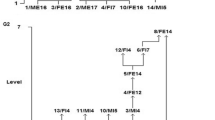Abstract
The group formation inPan paniscus is flexible as inP. troglodytes. A group consisted of 16.9 chimps on the average, and a large groups of more than 30 chimps were often observed. The most frequent groups are of the mixed group type, which occupied 80% of the observed cases. The group size varies in accordance with the seasonal changes of the abundance and distribution of food resources, but in general it is larger than that ofP. troglodytes. The socionomic sex ratio does not seem to be highly correlated with the group size, and was around 76 on the average. And neither the proportion of females with infants in a group nor that of estrous females seems to be correlated with the group size. Therefore, the group composition appears to be rather uniform. This uniformity may be attributable toP. paniscus's concentrative nature and high male/female affinity. In comparison with the other African anthropoid apes,P. paniscus shows less sexual differentiation in its social structure.
Similar content being viewed by others
References
Coolidge, H. J., 1933.Pan paniscus, pygmy chimpanzee from south of the Congo River.Am. J. Phys. Anthrop., 18: 1–59.
Harcourt, A. H., K. S. Stewart, &D. Fossey, 1976. Male emigration and female transfer in wild gorilla.Nature, 263: 226–227.
Itani, J., 1972.Social Structure of Primates. Kyoritsu-shuppan, Tokyo. (in Japanese)
————, 1977. Evolution of primate social structure.J. Hum. Evol., 6: 235–243.
Izawa, K., 1970. Unit groups of chimpanzees and their nomadism in the savanna woodland.Primates, 11: 1–46.
Kano, T., 1974. The pygmy chimpanzee.Shizen, 7: 28–37. (in Japanese)
----, in press a. An ecological and sociological study of the pygmy chimpanzee (Pan paniscus) on the right bank of the Njali River. In:The Pygmy Chimpanzee.T. Kano (ed.), NHK, Tokyo. (in Japanese)
----, in press b. Social interaction among pygmy chimpanzees. In:The Pygmy Chimpanzee.T. Kano (ed.), NHK, Tokyo. (in Japanese)
Kuroda, S., 1977. Pygmy chimpanzees in Wamba.Monkey, 21(6): 6–15. (in Japanese)
----, in press a. Social behavior of pygmy chimpanzees in Wamba. In:The Pygmy Chimpanzee,T. Kano (ed.), NHK, Tokyo. (in Japanese)
----, in press b. Natural life of pygmy chimpanzees in Wamba. In:The Pygmy Chimpanzee,T. Kano (ed.), NHK, Tokyo. (in Japanese)
Lawick-Goodall, J. van, 1968. The behaviour of free-living chimpanzees in the Gombe Stream Reserve.Anim. Behav. Monogr., 1(3): 161–311.
Nishida, T., 1968. The social group of wild chimpanzees in the Mahali Mountains.Primates, 9: 167–224.
————, 1972. Preliminary information of the pygmy chimpanzees (Pan paniscus) of the Congo Basin.Primates, 13: 415–425.
————, 1977a. Chimpanzees in the Mahali Mountains (I): Their natural life and structure of the unit group. In:Chimpanzee-ki,J. Itani (ed.), Kôdansha, Tokyo, pp. 543–638. (in Japanese)
————, 1977b. Social structure of chimpanzees. In:Jinruigaku-Kôza (Anthropology), Vol. 2 (Primates),J. Itani (ed.), Yûzankaku, Tokyo, pp. 277–314. (in Japanese)
Reynolds, V. &F. Reynolds, 1965. Chimpanzees of the Budongo Forest. In:Primate Behavior: Field Studies of Monkeys and Apes,I. DeVore (ed.), Holt, Rinehart & Winston, New York, pp. 368–424.
Savage, S., 1976. Pygmy chimpanzees: Update.Yerkes Newslet., 13(2): 25–26.
Schaller, G. B., 1963.The Mountain Gorilla: Ecology and Behavior. Univ. of Chicago Press, Chicago & London.
Sugiyama, Y., 1968. Social organization of chimpanzees in the Budongo Forest, Uganda.Primates, 9: 225–258.
Suzuki, A., 1969. An ecological study of chimpanzees in a savanna woodland.Primates, 10: 103–148.
————, 1976. Diversity of primate societies. In:A Special Number of Saiensuon Animal Sociology—Hominization.Hominization-Kenkyukai (ed.), The Nihon Keizai, Tokyo, pp. 22–35. (in Japanese)
————, 1977. Primate ecology. In:Jinruigaku-kôza (Anthropology), Vol. 2 (Primates),J. Itani (ed.), Yûzankaku, Tokyo, pp. 147–194. (in Japanese)
Uehara, S., 1976. Pygmy chimpanzees in Nkele.Monkey, 20(4): 6–11. (in Japanese)
Author information
Authors and Affiliations
Additional information
This study was financed by the Scientific Research Fund of the Ministry of Education, Science, and Culture of the Japanese Government.
About this article
Cite this article
Kuroda, S. Grouping of the pygmy chimpanzees. Primates 20, 161–183 (1979). https://doi.org/10.1007/BF02373371
Received:
Accepted:
Issue Date:
DOI: https://doi.org/10.1007/BF02373371




